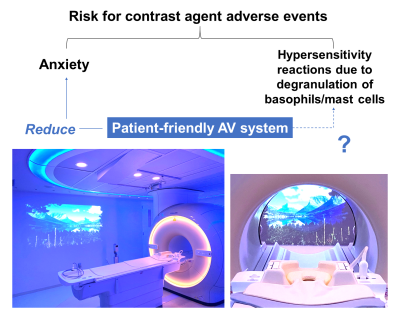4736
A patient-friendly audiovisual MR system reduce adverse reaction to contrast agents1Department of Radiology, Chiba University Hospital, Chiba, Japan, 2Diagnostic Radiology and Radiation Oncology, Graduate School of Medicine, Chiba, Japan
Synopsis
Patient anxiety could be a risk factor for adverse reaction to contrast agents. We hypothesized that a patient-friendly audiovisual system in the MR scanner room had a relaxing effect on patients and the occurrence of adverse reactions. As a result, the patient-friendly audiovisual system compared to the standard system reduced contrast agents reaction. Thus, this system may reduce adverse reaction in patients by providing a more patient-centered MRI examination environment.
Summary of Main Findings
A patient-friendly AV system was shown to reduce contrast agents reaction in many patients undergoing contrast-enhanced MRI examination compared to the standard system by providing a more patient-centered MRI examination environment.Introduction
Patient anxiety could be a risk factor for adverse reaction to contrast agents [1]. Many patients experience anxiety, not limited to claustrophobia, before magnetic resonance imaging (MRI) examination. Thus, the improvement of the patient experience during MRI examination (e.g., reduction of noise and feeling of confinement) is essential. A patient-friendly audiovisual (AV) system (Ambient Experience, Philips Healthcare, Best, The Netherlands) provides an AV imagery environment that features varying light conditions and individually selected visual wall displays with background sound effects. A previous report investigated the effects of exposure to a similar ambient environment in the waiting area and patient rooms of a pediatric emergency department and demonstrated that passive distractions using ambient lighting can reduce pain and anxiety in patients [2]. We hypothesized that patient anxiety could be reduced through passive distraction using the patient-friendly AV system, which would reduce the occurrence of adverse reaction. Therefore, we performed prospective observational study on the adverse reaction rate with and without the patient-friendly AV system.Methods
Subject: A review of the radiology information system databases identified 17541 outpatients (8899 female and 8642 men; median age, 62.4 years [range, 11–86 years]) who underwent head or/and neck contrast-enhanced (CE) MRI examination between January 2016 and September 2021. All patients were categorized into AV group with the patient-friendly AV system and control group without AV system.MRI examination: MRI was performed on a 3.0-T or 1.5-T unit using a head- or head and neck-phased array coil. The patient-friendly AV system featured a unique ambient light experience; Figure 1 shows the MRI environment. The patient-friendly AV system had overhead lighting that cycled through a spectrum of colors and intensities on a fixed schedule. On entering the gantry of the MRI scanner, patients could see the video projected on the light-emitting diode (LED) monitor via a prism mirror installed on the head coil. The progress of the examination was also displayed on the monitor, and the patient could confirm the end time. Furthermore, the patients could use headphones to listen to music corresponding to the projected image.
Evaluation: We investigated age, gender, previous history of gadolinium-based contrast agents (GBCA) reaction, and prevalence of adverse reactions in both groups. In patients with adverse reaction, GBCA, and magnetic field strength, adverse reaction grade, and symptoms were additionally investigated.
Statistical analyses: The Mann-Whitney U test was used to compare age between the AV and control groups. Fisher's exact test was used to compare sex, previous history of GBCA reaction, prevalence of adverse reaction, GBCA, magnetic field strength, and adverse reaction grade between the AV and control groups. Statistical significance was set at P < 0.05.
Results
Evaluated 17541 patients (AV, 5810; control, 11731), of which 123 patients (AV, 23 (0.40%); control, 100(0.85%)) had contrast agents reaction. Table 1 summarizes patient demographics. There was no bias between the AV and control groups in age, sex, previous history of GBCA reaction. Comparison of adverse reactions in the AV group and control is summarized in Table 2. Significant differences were observed in prevalence of adverse reactions of the two groups (odds ratio = 0.46, P = 0.0005). Table 3 summarizes demographics of patients with adverse reaction. There was no bias between the AV and control groups in age, sex, magnetic field strength, GBCA, and adverse reaction grade of the two groups.Discussion
We found that the patient-friendly AV system did have a significant contrast agents reaction-reducing effect compared to the standard system. Head and neck MRI examination is most anxious because confinement feeling of a patient within the head coil [3]. The patient-friendly AV system that allows they to not only listen to music, but also see the monitor image and the remaining scan time may be the only way to reduce the patient anxiety in the head and neck examination. Additionally, the greatest predisposing risk factor for an adverse reaction to contrast agents is a previous reaction [4]. There was no bias between the AV and control groups for a history of GBCA reaction. Although, we did not perform investigate on iodinated contrast media in this study.Conclusion
The patient-friendly AV system was shown to reduce contrast agents reaction in many patients undergoing CE-MRI examination by providing a more patient-centered MRI examination environment.Acknowledgements
The authors would like to thank the staff of the Department of Radiology at Chiba University Hospital for helping with the MRI examination.References
1.Lalli AF. Urographic contrast media reactions and anxiety. Radiology. 1974;112:267-71.
2.Robinson PS, Green J. Ambient versus traditional environment in pediatric emergency department. HERD 2015;8:71–80.
3.Murphy KJ, Brunberg JA. Adult claustrophobia, anxiety and sedation in MRI. Magn Reson Imaging. 1997;15:51-4.
4.ACR Committee on Drugs and Contrast Media. ACR Manual on Contrast Media. Version 9, 2013.
Figures



Table 2.
Comparison of adverse reactions in AV and control group.
[95% confidence interval]
